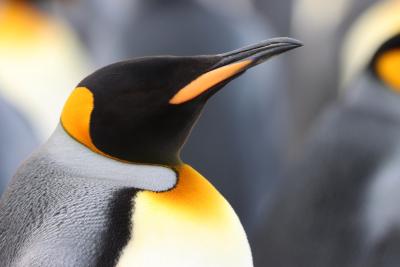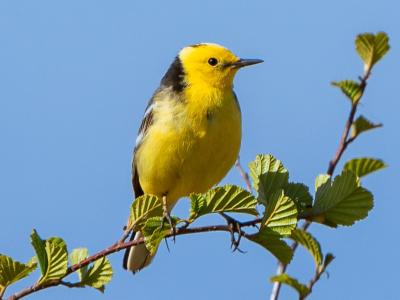Sweden: Fall Migration at Falsterbo
-
Sep 21-28, 2025
Stephen Menzie
Tour Price to be Determined
Tour Price to be Determined
The Scandinavian Peninsula is a vast region rich in birdlife. Every autumn, countless millions of breeding birds empty out of the northern forests and fells for southern climes. Located at the very tip of this landmass, Falsterbo acts like a very narrow delivery end of an enormous funnel. Consequently, it has long been regarded as one of Europe’s premier birding sites, and indeed the flight of birds there is one of the great natural spectacles on the planet. With migration already well underway in July, beginning with species on long-distance journeys to the equator or beyond, and continuing practically unabated through November, it is difficult to recommend a time to visit Falsterbo. Our tour aims for a transition period between movements of a diverse host of African migrants, including shorebirds, flycatchers, pipits, and warblers, and the staggering later-season flights of doves, finches, corvids, tits, and thrushes bound for continental Europe. This is also an excellent time for raptors, for which Falsterbo is arguably the best site in all of Europe. When the conditions are right, the sky is an ever-shifting gallery of kites, hawks, and falcons. And there is a good chance for rarities as well – just as Falsterbo funnels Northern Europe’s breeding birds, it is also bottleneck for any stray that might have wandered into the region.
We’ll keep a close eye on the weather (which is very often glorious and autumnal) and plan our days accordingly. On days of heavy migration, we will never tire of the gardens, pastures, and dune forests right around town. Much of the migration takes place overhead, and we may spend an entire morning in one location, waiting to see what passes by and over us. If conditions seem safe to leave, we’ll venture short distances off the Falsterbo peninsula to search for sparse local breeders like Black Woodpecker and Bearded Reedling, and visit good locations for shorebirds, gulls, and terns, always to return to our home base in the hamlet of Skanör (the sister-town to Falsterbo), and to lodgings in a beautiful historic inn. With excellent food, a gorgeous setting, a strong community of local birders, and world-class birding at a relaxed pace, Falsterbo is the place for anyone wishing to increase their experience with European birds, or, perhaps, simply with the wonders of bird migration.
Day 1: Our tour begins this morning in Denmark at Copenhagen’s Kastrup airport. Once gathered, we’ll head across the Øresund Bridge to Sweden. It’s about a 45-minute drive to the Falsterbo peninsula, where we’ll check into our cozy hotel in Skanör (the small town 5-minute’s drive north of Falsterbo). Once we’re settled in, we’ll have a short introductory meeting before talking a walk to some nearby wetlands or pastures. Depending on what’s been migrating that morning, these areas can be good for wildfowl, shorebirds, pipits, wagtails, finches, and perhaps some raptors. Night in Skanör.
Days 2-6: From our home base in the village, all the wonders of the Falsterbo-Skanör peninsula will be within easy reach. Our daily itinerary will hinge on the weather and the magnitude of bird migration. Most mornings we’ll be out at first light near the famous Falsterbo Bird Observatory lighthouse gardens. On days of heavy migration, the sky can be filled with an unceasing passage of wagtails, pipits, finches, corvids, doves, and, as the morning increases, raptors. One of the long lasting memories of Falsterbo will be seeing a sky full of birds on a good morning, and the experience is as much about the sight and sound of tens-of-thousands of birds in flight overhead as it is about the variety of species. Because Stephen’s day job is Observatory Manager, we’ll also be able to gain unique access to the banding in the lighthouse garden, giving us the chance to see many of the migrants up close and personal, as well as taking a look at the important scientific work that the observatory does.
Our mornings at the point will allow us to assess the day’s migration and determine how we’ll spend the rest of the day. When the weather is right, the birds keep coming, and we’ll want to spend as much time as we can birding the gardens, marshes, and meadows (as well as the golf course!) around the point on the hunt for any birds that have chosen to land, while always keeping an eye to the sky where the bulk of the action remains. We’ll also take pleasant walks through a forested area which opens up to rolling sand dunes and a large heath. Here, when the raptors are on the move, one can sit down and watch a stream of Eurasian Sparrowhawks, Red Kites, Eurasian Kestrels, Eurasian Hobbies, and Common and European Honey Buzzards, all the while noting warblers, tits, and other songbirds flitting through the birches and pines. Lunch will be taken in a nearby restaurant – several of which have terraces and outdoor eating areas, so keep your coats on as we will be eating al fresco. On previous trips, lunch-time sightings have included White Stork, Black Kite and White-tailed Eagle.
While it is the prospect of staying put and letting the birds come to us which is the great appeal of spending a week at Falsterbo in the height of fall migration, we’ll take some time to visit local areas of interest off the peninsula. One such is Lomma Bay, just north of Malmö, which can be excellent for gulls and shorebirds, while the nearby campus of Alnarp, with its many plantings and some very old oaks, is often good for migrants as well as resident woodland birds. We’ll also visit Lake Krankesjön, where we’ll hope to find species not typically present at Falsterbo, including Common Crane, Bearded Reedling, and perhaps Crested Tit if we’re lucky. Other times we may venture along the southern coastline in search of shorebirds, terns, and gulls. And, with a strong community of birders in the area, we’ll stay updated as to what is being seen, and will be prepared to go in search of any rarities that may turn up in the region.
Regardless of whether we remain at Falsterbo or venture farther afield, our days promise to be filled with first-rate birding, fresh air, good meals, optional downtime, and minimal time on the road. All nights in Skanör.
Day 7: After morning birding, we’ll make our way towards Malmö, Sweden, across the straight from the Kastrup airport in Copenhagen, sometime after lunch. Depending on how we’ve fared, we may do some birding in somewhere along the way. Night in Malmö.
Day 8: The tour concludes this morning with transfers to Copenhagen’s Kastrup airport.
Note: The information presented here is an abbreviated version of our formal General Information for Tours to Sweden. Its purpose is solely to give readers a sense of what might be involved if they took this tour. Although we do our best to make sure what follows here is completely accurate, it should not be used as a replacement for the formal document which will be sent to all tour registrants, and whose contents supersedes any information contained here.
ENTERING AND LEAVING DENMARK AND SWEDEN: The regulations for both countries are the same: a passport valid for at least three month after the conclusion of your stay and with at least two blank pages for entry stamps. Visas are not required for stays of under 90 days. Citizens of other countries should contact their nearest Danish and Swedish consulates or embassies for the rules applicable to them.
COUNTRY INFORMATION: You can review the U.S. Department of State Country Specific Travel Information here: https://travel.state.gov/content/travel.html and the CIA World Factbook here: https://www.cia.gov/the-world-factbook/. Review foreign travel advice from the UK government here: https://www.gov.uk/foreign-travel-advice and travel advice and advisories from the Government of Canada here: https://travel.gc.ca/travelling/advisories.
PACE OF THE TOUR: This is a fairly relaxed tour. Breakfast will be between 7.00 and 8.00am, allowing us plenty of time to arrive at the prime spots soon afterwards. Lunch will usually consist of either a picnic in a scenic area or a casual sit-down at a local restaurant. We will return to the hotel in time to freshen up for dinner at one of several excellent restaurants in the area.
Virtually all the walking is fairly easy on good paths or trails. Most of the birdwatching is done within a short distance of our vehicle. In fact, at Falsterbo, one of the main routes of the migrating birds is directly over the car park and adjacent bird observatory wood. With the variable weather conditions the birdwatching itinerary will be decided on a daily basis by the leader.
HEALTH: The Centers for Disease Control and Prevention (CDC) recommends that all travelers be up to date on routine vaccinations. These include measles-mumps-rubella (MMR) vaccine, diphtheria-tetanus-pertussis vaccine, varicella (chickenpox) vaccine, polio vaccine, and your yearly flu shot.
The most current information about travelers’ health recommendations can be found on the CDC’s Travel Health website here: https://wwwnc.cdc.gov/travel/destinations/list
Smoking: Smoking and vaping are prohibited in the vehicles or when the group is gathered for meals, checklists, etc. If you are sharing a room with a nonsmoker, please do not smoke in the room. If you smoke in the field, do so well away and downwind from the group. If any location where the group is gathered has a stricter policy than the WINGS policy, that stricter policy will prevail.
CLIMATE: Temperatures will typically range from 10°C (about 50°F) in the morning to a maximum of 18°C (65°F) at midday, although it can be (or feel…) colder if overcast and windy, and warmer temperatures are likewise possible. The average rainfall in September is 60mm (2.36 in) and showers are always a possibility.
ACCOMMODATION: Our small hotel is located in the quaint village of Skanor, just to the north of Falsterbo, and within walking distance of the sea and prime birding areas. The rooms are typical of this kind of hotel being simple and not too large but very clean and have adjustable heating to suit individual needs. All rooms have a bathroom with shower facilities, and towels are provided. The last night of the tour will be in Malmo, Sweden, a 15-minute train ride from the airport in Copenhagen, to facilitate departures on the last day.
Internet Access: Our hotels have wireless internet access.
FOOD: Modern Swedish cuisine is generally accessible, diverse, and excellent. Opportunities will be had as well to explore some classic Scandinavian dishes. Since there are only a few establishments open at Falsterbo out of season, we are likely to eat in some of the restaurants on more than one occasion.
Food Allergies / Requirements: We cannot guarantee that all food allergies can be accommodated at every destination. Participants with significant food allergies or special dietary requirements should bring appropriate foods with them for those times when their needs cannot be met. Announced meal times are always approximate depending on how the day unfolds. Participants who need to eat according to a fixed schedule should bring supplemental food. Please contact the WINGS office if you have any questions.
TRANSPORTATION: Our transportation will be by mini-bus driven by the leader. We will rotate the seating each day.
Interactive Map
2023 Narrative
It was another excellent week of migration-watching and birding in southern Sweden, with our first full day on the Falsterbo peninsula proving to be perfect for a mass movement of finches: 60,000 Common Chaffinches, 10,000 Eurasian Siskins, and a supporting cast of several other species. Over the course of the week, we caught up with 137 species, including multiple birds characteristic of the region and Falsterbo in particular: a Pallid Harrier, three Red-throated Pipits, a Black Woodpecker, Crested Tits, Bearded Tits, white-headed Long-tailed Tits, multiple Firecrests two Hobbies, three White-tailed Eagles, a Great Grey Shrike, and a night-time Tawny Owl. Add that on top of a week with beautiful coastal scenery and plenty of good food, and it was a trip to remember!
IN DETAIL: After gathering at Copenhagen International Airport on Sunday 24th October, we crossed the Öresund Bridge into Sweden and headed straight for Trelleborg on Skåne’s south coast. There, we found a host of birds to kick our tour off with, including hordes of Greylag Geese, European Herring Gulls and Northern Lapwings. Three handsome European Golden Plovers dropped in, where they joined a Ruff and a Common Redshank and, in the nearby bushes, we enjoyed good views of our first Common Chiffchaffs as well as our only Lesser Whitethroat of the week.
After a delicious Chilean-inspired lunch (at a restaurant run by a former winner of Swedish MasterChef, no less), we got back to birding. On the pools close to the restaurant, we enjoyed close views of Common Greenshanks and Wood Sandpipers, as well as a migrant Great Spotted Woodpecker, which landed briefly in a small tree by the parking lot.
Checking into the hotel, some of the group were lucky enough to see our first Common Cranes of the tour: a party of that flew directly overhead. A wander north of the hotel saw us catching up with Common Redstart and Eurasian Curlew.
Our first full day on the peninsula dawned and, even from the short walk from the hotel to the van, it was apparently that today was going to be a good day for finch migration. We hotfooted it to Falsterbo lighthouse, where, before we’d even parked the car, flocks of migrating Common Chaffinches and Eurasian Siskins were evident, passing low over the golf course and along the coast. Over the next hour, we were mesmerised by around 60,000 migrating Common Chaffinches, 10,000 Eurasian Siskins, hundreds of Blue Tits and Meadow Pipits, and smaller – but still equally impressive – numbers of scarcer species such as Woodlarks, Common Crossbills and European Goldfinches. Raptors were on the move, too, with dozens of Eurasian Sparrowhawks, a European Honey-buzzard, and a Eurasian Hobby, which battled slowly into the headwind – a rare, prolonged sighting of this usually fleeting falcon.
From the lighthouse, we made the short walk to the southernmost terra firma at Falsterbo – Nabben. Here we continued to enjoy the wonderful migration, adding Red-throated Pipit (a duo migrating at close range) and Common Scoter to the list, as well as Common Pochard, Pied Avocet and Black-bellied Plover, all three of which were present on the lagoon.
After lunch, we headed to an area just north of the peninsula and onto the peninsula at Lilla Hammar. Here, we found several Great Egrets, a White-tailed Eagle, a Hen Harrier, a Yellow Wagtail amongst the much more numerous Whites, and our third Red-throated Pipit of the day. News was filtering through of a steady stream (well, eight) of Pallid Harriers passing through Falsterbo since we left, so the decision was made to head back onto the peninsula to find a 9th – a heady task, considering eight was the second-highest day total on the peninsula ever. Surely southern Skåne was empty of Pallid Harriers by now… but apparently not! Over the reed bed north of the lighthouse, with a juvenile Hen Harrier from comparison, we found a chocolate-orange juvenile male Pallid Harrier!
On Tuesday morning, migration slowed somewhat, but impressive number of finches and pipits were still passing over when we reached the reed beds at Flommen. We were treated to a close view of some birds that had been caught for banding, including a Common Reed Warbler and a male Blackcap. While standing at Flommen, we could hear a Black Woodpecker calling in the distance so, before lunch, we went to investigate at a likely spot – Falsterbo Park. Initially there was no sign of any Black Woodpeckers, so we settled down with some tea and coffee for a spot of raptor watching. This turns out to be particularly productive, with plenty of European Honey-buzzards, Common Buzzards and Red Kites passing overhead, as well as a single Hen Harrier and at least six Black Kites. Before we left for lunch, we checked one last time for Black Woodpeckers – and there was one! A male Black Woodpecker gave spectacular views as it drummed and called from the top of a dead tree just a matter of yards away from us. After lunch, we headed back to Trelleborg where, amongst the usual suspects, we found several Caspian Gulls and two Rock Pipits.
On Wednesday, day 4, we headed north of Malmö to start the day at the Swedish agricultural college’s Alnarp campus. The campus consists of a mature woodland and arboretum and is a haven for woodland birds. Before we’d even left the parking lot, we enjoyed close views of several Blackcaps feeding on berries in a hedge. Carefully checking the Yews and coniferous trees, we found five Firecrests. Elsewhere, we encountered Eurasian Nuthatches, a Eurasian Treecreeper, plenty of European Robins, and a brief Green Woodpecker. Next, we drove the short distance to the coast at Lomma. Here, in the shallow, sandy bay, we found a flock of Dunlin, two Caspian Gulls (including a Czech-ringed bird), a single Red Knot and, offshore, a Razorbill.
After lunch on the university campus, we headed south via the centre of Malmö. A brief stop added Common Moorhen to the list – which, unlike its North American equivalent, the Common Gallinule, is happy to strut around out in the open. A little further south, just out of the city boundary, we stopped at Klagshamn. A host of waterbirds were present in the bay, including three (very) distant Dark-bellied Brants.
Day 6, September 28th, we headed inland, first to the Vomb area. Within moments of stepping out of the vehicle, we were treated to point-blank views of our too woodland target species: Marsh Tit and Crested Tit. Often, these species can take a little searching for, so this quick find put us well ahead of schedule. We used to available time to head to the Krankesjön. In the woodland by the car park, we found a mixed tit flock, including many Long-tailed Tits – like little snowballs with long tails, and perhaps the cutest bird of the tour! A little further on, we struck gold: a flock of about 15 Bearded Tits picking gravel off the boardwalk. We enjoyed unobscured views of these usually elusive birds for a good ten minutes or so.
One more stop before lunch – the grand riding stables at Flyinge Kungsgård, where we caught up with 16 White Storks, including a pair making a very late (or very, very early?) nesting attempt. We headed to Dalby in search of ‘Malmö’s national dish’ – falafel – via a quick stop to see a Viking rune stone. After lunch, we briefly visited the forests around Vomb again before returning to Krankesjön, this time to the observation tower. Our luck continued, with a fly-over Lesser Spotted Woodpecker and our second Eurasian Hobby of the trip. Just as we were leaving, we found two Yellowhammers in the car park.
The day wasn’t over yet, though; after dinner, we headed out into Falsterbo park with a thermal-imaging scope and a torch. After a short while, we had eyes on our target: a Tawny Owl, which showed well in the tree above us and then flew straight over our heads.
We started early on Friday morning with a pre-breakfast walk to the coastal trig point west of the hotel. Here we found a host of shorebirds, including our first Bar-tailed Godwits of the tour and a single Black-tailed Godwit.
After breakfast, we drove to the north end of Knösen, where we found a flock of migrant Goldcrests, before we returned to the Skanör harbour area, where we were treated to great views of Common Greenshank and Common Snipe, as well as close looks at ten Spotted Redshanks.
In the afternoon, we went inland to the area around Skurup. On the lake at Näsbyholm, we found hundreds of Greylag Geese and Common Pochards, with dozens of Red Kites and a fly-by Hen Harrier also present in the area. By the quaint town of Gärdslöv, a stop to look at a melanistic Common Pheasant led us to a sunflower field full of finches – mostly Chaffinches, but with several tens of Bramblings, too. Finally, we stopped at a viewpoint where two White-tailed Eagles were present.
On our final day, we started at Falsterbo lighthouse, where we were able to peruse the observatory shop and enjoy a cinnamon bun. A strong westerly wind meant that most activity was on the sea this morning, with large flocks of Common Scoter and Common Eider, as well as five brief Velvet Scoters. Despite the wind, there was still a reasonable passage of finches overhead, predominantly Common Chaffinches. Ahead of lunch, we too a look around the southern end of Knösen, close to the new cemetery and an area known as Robert’s Dunge. Here we encountered what, relatively speaking, might have been the rarest bird of the trip – although it wasn’t a new bird for the list. It was a Marsh Tit, a bird that is less than annual at Falsterbo with just six banded in the observatory’s 43-year history. In the same patch of wood there was a Firecrest and, on the other side of the horse paddocks, a Great Grey Shrike was perched on top of a solar panel.
After our last lunch on the peninsula, we decided to make the most of the strong southerly winds with some seawatching off Malmö. Several Razorbills passed by, including some at close range, as did half a dozen Caspian Gulls, our only Lesser Black-backed Gull of the trip and, diving offshore, ten or so Northern Gannets. A migrating Merlin dashed by just as we were leaving – a fitting end to a blustery day and an exceptional week of migration-watching in and around Falsterbo.
In total, 137 species were seen by the group during the week – a new record for the trip.
All that was left was for the group to decided on their ‘bird of the trip’ – and it was a tough choice, with several fine candidates. Crested Tit, Bearded Tit, Black Woodpecker and the impressive migration of Common Chaffinches all made the top 5, but the winner once the votes had been counted up was Falsterbo Park’s Tawny Owl.
Stephen was a delight, he gave us the insider's view of bird banding and migration at Falsterbo. In addition, he provided a running commentary on an outsider's perspective on life in Sweden. We ate at fantastic restaurants, learned a lot about Viking history, stopped at a Viking museum and rune stone.
- Dana L. on Sweden: Fall Migration at Falsterbo
Maximum group size seven with one leader or nine with two leaders.










































